by Winding Pathways | Jul 13, 2017 | Chickens, Labyrinths, Wonderment
What fun hosting Bankers Trust staff and clients and welcoming an out of town visitor to the Phoenix Harmony Labyrinth. Tuesday, July 11 was steamy and threatening storms. But, the hardy crew engaged in lively discussions and asked probing questions about the more simple lifestyle we embrace at Winding Pathways. Now, simple does not mean easy. Tending a large yard and five circuit labyrinth are work. Rewarding work. And, people are curious about chickens, managing small gardens, maximizing space, retaining water on our property, heating with wood, and creating diversity that welcomes wildlife. Topics like ways to save energy which saves money to be invested or used caught their attention. And questions on managing pests like ground hogs and deer. We touched on a lot and had a great time.
Go to 1080 Labyrinth for a photo album of the afternoon and evening.
Then, with storms obviously to the south showing off cumulus and anvil clouds but no threat, all walked the Phoenix Harmony Labyrinth. Mike T’s comment summed it all up. As he and Terri entered the center a cool breeze touched their faces. Mike paused and said, “I never want to leave.”
Thanks Terri Doyle for organizing and promoting!
by Winding Pathways | Jun 15, 2017 | Chickens, Hoover's Hatchery
If you missed our first Facebook Live watch this Hoover’s Hatchery video.
We chatted about Chickens and Gardens, Insects and Pests, Keeping Chickens cool in the summer and free from insect bites and predator invasions, and gave some tips on keeping water and feeders “poop” free.
We’re live with Winding Pathways talking with Hoover’s Hatchery about gardening with chickens!
Posted by Hoover’s Hatchery on Thursday, June 15, 2017
Join us next time.
by Winding Pathways | Jan 5, 2017 | Chickens
Note: Winding Pathways is not paid by companies we feature nor do we receive any free material goods. We simply have had great results with their products in our yard.
Although most of the United States is still in the grip of winter, cold weather makes thinking about spring pleasant. It’s also a great time to prepare for summer yard and garden projects. Here are three catalogs or websites we enjoy reading when it’s cold out.
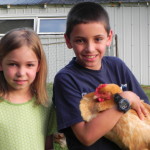
Children with
“Golden Hen.”
HOOVER’S HATCHERY: Located in tiny Rudd, Iowa, this hatchery has greatly expanded the number of chicken breeds it sells-even such rare ones as lavender Orpingtons. Now is the time to begin preparing for hosting baby chicks this spring. Check out Hoover’s Website. Many breeds are scarce and although it’s too early to receive baby chicks in mid-winter, by ordering soon, customers are more likely to receive their favored breeds. For information on backyard chickens type “chickens” in the Winding Pathways search and several blogs will appear.
SEED SAVERS EXCHANGE: Not far from Rudd is Seed Savers Exchange in Decorah, Iowa. They feature an amazing array of garden seeds. We buy many of our seeds from them and especially like trying their heritage varieties of tomatoes, beans, squash and many other vegetables featured in their catalog. Type “squash” in the Winding Pathways search and blogs on our love of winter squash will appear.
RAINWATER SOLUTIONS: Seeds need water to grow and it doesn’t always rain at the right time. A solution is to harvest rain that flows off the roof and store it in a rain barrel for later use. We have five rain barrels at Winding Pathways and use the water constantly. Now is a great time to order a barrel for use as soon as the temperatures consistently stay above freezing. Check out their website at. Type “rain barrels” in Winding Pathways search and a couple of blogs will appear.
The Linn county Master Gardeners column “From the Ground Up” featured an article on “Ordering Seeds From Catalogs” on January 1st. Living section 4L.
by Winding Pathways | Dec 30, 2016 | Chickens
Mid-winter is a perfect time to order baby chicks to arrive in the mail as the weather warms in spring. Homeowners can create an international flock of six hens that will be fun to keep and produce many delicious eggs.
Many hatcheries allow customers to order a mixture of breeds, but often they require buying 25 birds so the chicks stay warm during shipment. Winter is a perfect time to get together with other families who keep chickens to place a joint order to meet the minimum. Stores that stock chicks will usually sell as few as six, but their breed selection is normally limited.
Winding Pathways encourages folks to start browsing catalogs and on-line sites now and order soon to make sure desired breeds are in stock.
We’ve been keeping chickens of many breeds for decades at Winding Pathways. Both our children, now adults living in distant states, grew up tending our small flock. We love our fresh eggs and also appreciate the personalities and characteristics of our favorite breeds.
It’s easy to create an international flock. Here’s how we’d choose breeds for a six-bird flock that come from many places, are fun to be around, and lay plenty of eggs.
One Buff Orpingtons. This is a golden hen developed in England. Large, fluffy, and gentle. Orpingtons are so-so layers but absolutely beautiful, fun to be around, and easy to care for. A young chick enthusiast named ours “The Golden Hens”.
One Rhode Island Red or New Hampshire Red. We like having a “Yankee” chicken in our flock. Rhode Islands are dark reddish in color and are outstanding layers. New Hampshires are a lighter red and good layers, although perhaps not quite as good as Rhode Islands.
One Barred Rock. Sometimes called Plymouth Rock, there are several colors of the rock breed and all are good. Not quite as friendly as the Orpingtons but a better layer. This is another “Yankee” breed either named for Plymouth Rock in Massachusetts or developed by a breeder in Plymouth, NH, depending on the source of information.
One Americana. People love the blueish/greenish eggs this breed lays. They are good layers that originated in South America.
One Maran. This French breed lays very dark brown eggs. Marans come in various feather colors that children love to gather. We sometimes collect feathers and give them to our fly-fishing son-in-law who ties his own flies.
One beautiful and unusual bird. Look at the photos in printed hatchery catalogs and on websites and choose an interesting and colorful brown egg layer. Often these ornamental breeds aren’t great egg layers, but they are interesting and colorful. Some possibilities include Wyandottes, good layers developed in New York; Brahmas, perhaps from India; Cochin, not so good layers but named for Cochin China – near the mouth of the Mekong River in Vietnam; Sussex, a good layer from England; Jersey Giants from New Jersey; or Buckeyes from Ohio.
In recent years we’ve purchased our chicks from Hoovers Hatchery but we’ve also bought them from McMurray Hatchery. The following three hatcheries have interesting websites and provide outstanding chicks of many breeds: Cackle Hatchery; Murray McMurray Hatchery; Hoovers Hatchery.
-
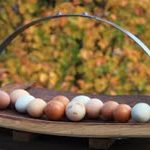
-
A variety of chickens lay beautiful and nutritious eggs.
-
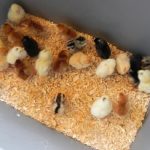
-
Newly arrived chicks.
-
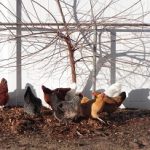
-
Chickens grind up garden residue.
-
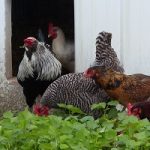
-
Enjoying greenery.
by Winding Pathways | Oct 30, 2016 | (Sub)Urban Homesteading, Chickens, Energy Efficiency
One late October afternoon Rich brought only three eggs into the kitchen. In spring and summer our 15 hens normally give us a dozen beautiful eggs every day. Like so many signs in nature our chickens are telling us it is transition time.
We have lucky chickens. They enjoy good food, safe living space, and daily fresh air, sunshine, exercise and natural food. Seasons shape their lives, but even their unfortunate counterparts living in cramped cages in factory farms are not completely immune to seasonal changes of nature.
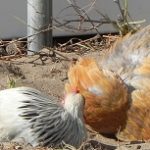
When molting chickens lounge, take dust baths, and re-grow new feathers.
A hen starts laying when she’s four to five months old and stays laving for 12 to 14 months. Egg laying is tough on bodies and after a year chickens need a vacation. So hens call time out. They shed old worn out feathers and grow new ones, rest and eat as they build back strength. After a month or two they look great in their new feathers and begin laying again – if they are fortunate enough to live in a backyard flock.
Commercial egg operations kill hens as they begin to molt and replace them with young birds. Not us. We keep our birds for at least two years. In their second lay cycle our hens give us slightly fewer eggs but they are huge with bright yellow/orange yolks in shells of various hues.
Molting is caused, in part, by the age of the bird, but declining daylight is a major factor. Nature has programmed chickens to lay the most eggs in spring. As fall’s days shorten production drops. We let our chickens enjoy seasonality. Commercial eggeries don’t. Their unfortunate hens live in windowless buildings with lighting that simulates spring to stimulate peak production.
Declining day length triggers thousands of reactions in our world outside the living room windows. Here are just a few things we notice:
-

A still day of reflection on Turtle Stump.
Leaves of our sugar maples turn vibrant red/orange before drifting to the ground like snow. Our black, white, and red oak leaves wait a bit later until turning rust colored and shedding, although some oaks keep dead leaves all winter.
- White footed mice, box elder bugs, and Asian beetles try their best to get into the house before cold weather settles in.
- There are comings and goings in the yard. We’ve said “goodbye” to house wrens, orioles, grosbeaks, warblers and many other birds but are delighted to welcome back juncos from their nesting grounds up north. Hawks, geese, and even pelicans pass overhead on their way south.
- The world sounds and looks different as humid summer air transitions into fall’s dryness. Colors are more vibrant in low humidity air, sound transmits more clearly, and late afternoon sunlight dances across tree trunks and drying prairie grasses.
-
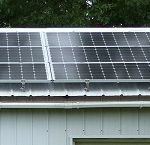
Sunlight hits our solar panels at a different angle in the fall and winter.
We produce a bit less electricity from our photovoltaics because the sun isn’t shining as long each day, but peak production is earlier in the day than in midsummer
- Sitting outside on a bright autumn day lets us soak in the sun’s delicious warmth but it cools quickly as the sun drops. Then, we go inside to enjoy the warmth our wood stove provides.
- Clouds drift by and sunrises and sunsets are particularly colorful.
- Autumn and winter constellations enchant viewers and linger into the darker mornings. Because the temperatures are mild, star gazing is pleasant.
Fall is a beauty filled season. We encourage you to “Go outside and play!”








